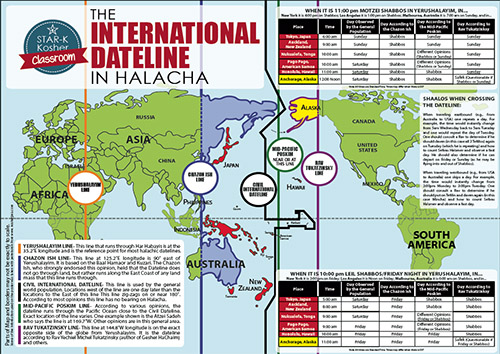
These past two weeks we have introduced Rav Mordechai Kuber’s spectacular new three-volume collection titled “Crossing the Dateline,” the authoritative sefer on the halachic ramifications of the International Dateline (IDL). Together with more than 30 TABC students, we devoted our recent intersession to delving into this magnificent sefer capped by hearing directly from Rav Kuber via Zoom.
We have identified the halachic dateline location and discussed one’s halachic obligations when crossing the dateline to the west. We conclude our discussion by presenting a sampling of halachot for crossing the dateline to the east.
Crossing the Dateline
To the East Into ‘Yesterday’
Last week we presented Rav Ovadia Yosef and Rav Hershel Schachter’s views that one’s current location determines one’s halachic obligations on the land, sea or the air. We also noted that when one crosses the dateline to the east, he travels into “yesterday” or the previous day.
Sunday—Shabbat—Sunday
Returning to New Jersey from Hong Kong, my wife and I left Hong Kong Sunday morning. Soon after takeoff, we crossed the 90-degree line east of Jerusalem, which is the dateline according to the minority opinion of the Chazon Ish. We wanted to accommodate this opinion, at least as far as Torah-level prohibitions are concerned, so we refrained from writing or using electronic devices at this point in our journey.
We used the bathroom, though, assuming that triggering its fluorescent bulbs constitutes a rabbinic prohibition. This question is also a matter of great contention, with most rabbis siding in case of need with Rav Shlomo Zalman Auerbach that only a rabbinic violation is entailed, unlike the Chazon Ish, who believes it is a Torah-level obligation.
Once, however, we crossed the IDL to the east, we reentered Shabbat according to a more mainstream view. At this point we refrained even from rabbinic prohibitions. Not long afterward, the sun set, returning us to Sunday.
Rav Kuber clarifies that one undoubtedly enters Shabbat “in progress.” We derive this point from Yevamot 33a, which addresses the situation of a young person reaching puberty on Shabbat. The Gemara teaches that even if this occurs during Shabbat, the obligations to observe Shabbat are now in full adult force.
Rav Kuber addresses the permissibility of taking a journey that enters Shabbat mid-flight. He clarifies that it is undoubtedly forbidden to take off or land on Shabbat. Moreover, it is a violation of the spirit of Shabbat to fly on Shabbat even if one takes off before Shabbat and lands after Shabbat. For example, one should not take a flight that leaves Los Angeles before Shabbat begins and lands in Israel after Shabbat ends.
By contrast, one has already observed a complete Shabbat in Asia before boarding the Sunday-Shabbat-Sunday flight. Thus, Rav Kuber explains, it is appropriate to take such a flight, especially in case of need. He cites Rav Yisrael Gustman and Rav Chaim Pinchas Scheinberg who agree, although Rav Yosef Shalom Eliashiv feels it is preferable to avoid taking such a flight. Since I needed to return to teach at TABC the Monday morning after teaching in Hong Kong on Shabbat, it was appropriate for us to take a flight that would enter Shabbat for a brief period mid-air.
Mitzvah Performance On the Repeat Day
Crossing the dateline to the east entails the question of mitzvah obligation on the repeated day. For example, if one observes Purim in Hong Kong and the evening afterward he takes a return flight to the United States, must he read the Megillah again during the portions of his trip he re-enters Purim?
Rav Shlomo Zalman Auerbach (Teshuvot Minchat Shlomo 1:23) believes that he is obligated to observe Purim a second time. He compares the situation to one who, after keeping Purim on the 14th day of Adar in Beit Shemesh, travels to Jerusalem that night and sleeps over. In such a case, he must celebrate Purim a second time on the 15th of Adar.
However, Rav Shlomo Zalman’s ruling is subject to debate. There seems to be a difference between observing Purim for a second time on the 15th of Adar and observing it for a second time on the 14th of Adar. Rav Kuber cites both Rav Moshe Feinstein and Rav Yosef Shalom Eliashiv, who disagree with Rav Shlomo Zalman Auerbach.
Rav Ovadia Yosef (Yalkut Yosef Orach Chaim 37:10) signals his fundamental agreement with Rav Moshe and Rav Eliashiv. However, he indicates that it is worthwhile accommodating Rav Auerbach’s view for Torah-level obligations such as kriat Shema and tefillin. Rav Ovadia’s compromise is recommended.
Conclusion: Much More Discussed In Rav Kuber’s Monumental Work
We conclude our presentation of highlights of Rav Kuber’s new three-volume masterpiece on the IDL by noting that we have presented only a fraction of the issues. There are many more fascinating and hotly disputed issues we have not touched upon. These include the date for Shabbat observance at South Korea’s Incheon International Airport and Phillip Island, 14 miles southeast off the Australian coast. Rav Kuber also tackles many other questions, such as the issues of fasting, tahara, and Sefirat HaOmer when crossing the dateline in either direction.
Finally, Rav Kuber tackles the issues of tefillah during flights that take a polar route. During these flights, one can cross 11 time zones in only one hour! He also discusses tefillah for astronauts and much more. Rav Kuber’s exceptionally well-written sefer is a riveting must-read for contemporary Jews.
Rabbi Haim Jachter is the spiritual leader of Congregation Shaarei Orah, the Sephardic Congregation of Teaneck. He also serves as a rebbe at Torah Academy of Bergen County and a dayan on the Beth Din of Elizabeth.












